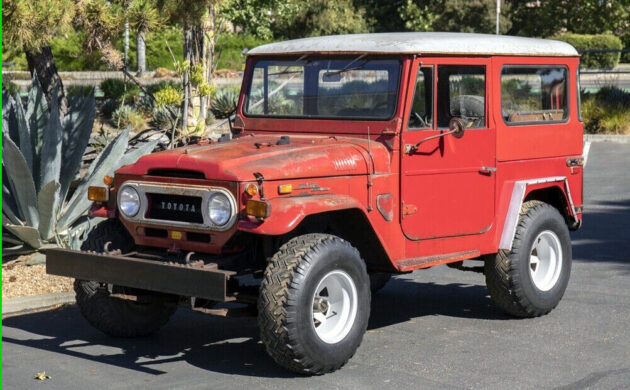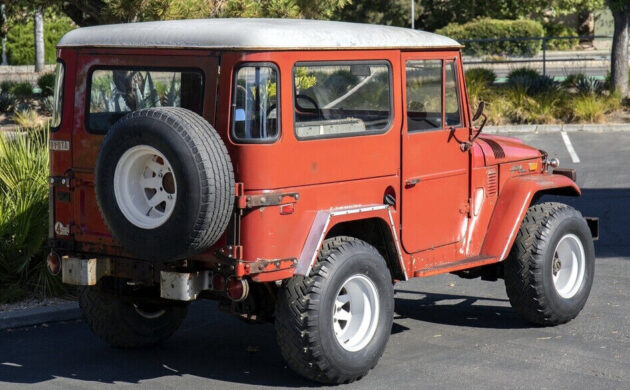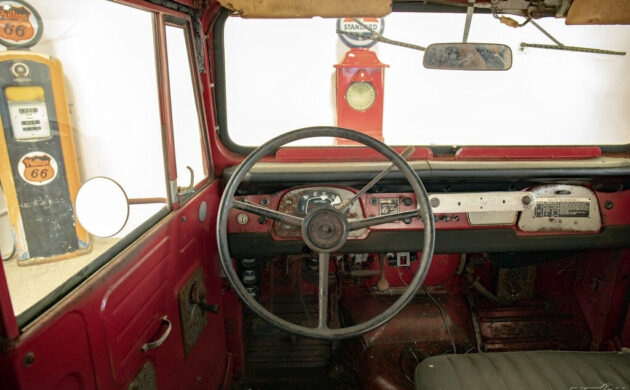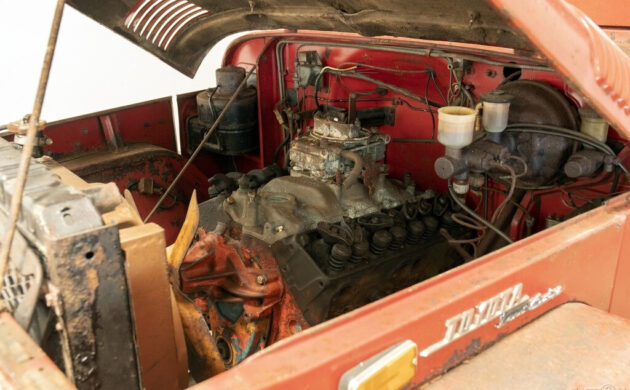The Toyota Land Cruiser enjoys a well-deserved reputation for toughness. Various organizations and government agencies have utilized these classics to access some of the most inhospitable locations on the planet. Some private owners sought more power and torque than provided by the standard engine, so V8 transplants were common. That is the case with this 1971 Cruiser, although the seller offers a further engine option. They have listed it here on eBay in Pleasanton, California. Bidding has hit $6,500 off the back of solid interest but remains short of the reserve. For those wishing to bypass the auction, there is a BIN option of $15,995.
The seller indicates the Land Cruiser has lain idle for forty years, and it may be an engine issue that was the culprit. We’ll get to that shortly, but we need to consider this vehicle as an overall package. The red paint shows its age, and someone has added some pretty second-rate rear fender flares to cover the significantly larger wheels and tires. However, with the panels looking remarkably straight, addressing those two issues should not be challenging. Given the potential value locked away in this Toyota, the new owner may elect to tackle it as a frame-off restoration. The frame itself looks like it wears nothing beyond surface corrosion, and the only visible rust is in the very back section of the rear floor. Stripping the Cruiser to the last nut and bolt would allow the buyer to address that flaw to a high standard and return the entire vehicle to a factory-fresh state.
There is little chance an owner would slip behind the wheel of a Land Cruiser of this vintage and mistake it for a Cadillac. Luxury appointments were virtually unknown at the time this one rolled off the line, and apart from a heater, there are no creature comforts. The interior condition is consistent with the exterior appearance, meaning that the painted surfaces need refreshing. The seat upholstery and foam are beyond help, while the horn button is missing from the wheel. However, whipping the interior into shape should not be complicated or expensive if the buyer does pursue a frame-off build. Some fresh paint, new seatcovers, and a rubber mat on the floor should have it sparkling like a new penny.
Toyota built its reputation on toughness, with drivetrain components that withstood harsh treatment. In the days before transmissions like the Borg-Warner T-5 and Tremec T56 became readily available, it was pretty common to find owners of older passenger cars swapping a Toyota steel-case five-speed under their vehicle to improve performance and long-distance cruising ability. I wouldn’t say the company over-engineered its drivetrain components, but it left itself with a greater safety margin than most of the competition. The 1971 Land Cruiser rolled off the line with a 3,878cc six-cylinder engine producing 125hp and 209 ft/lbs of torque. Bolted to that six was a three-speed manual transmission that sent the power to two or four wheels via a dual-range transfer case. With the maximum engine power and torque appearing low in the rev range, the Cruiser could crawl across some rough ground. However, some owners wanted more, and V8 transplants were common. That is the case with our feature vehicle, with its engine bay now home to a Chevrolet small-block of unknown capacity or specifications. There may be some issues with the V8 because someone has removed the valve covers and oil pan. That could explain why it has hibernated for four decades, but it also isn’t the end of the earth. If the existing motor is beyond salvation, bolting in another Chevy powerplant would be easy. For those craving originality, the news is even better. The seller includes the original six-cylinder unit in the sale, although its condition is unknown. If the buyer intends to return the vehicle to factory specifications, this would be the ideal time to treat the motor to a refresh.
The legendary status of the Toyota Land Cruiser is reflected in its retained value. Like the First Generation Ford Bronco, the early-1970s Cruisers can achieve excellent prices in the current market. A meticulous restoration with the original engine back under the hood could see this one command a price above $70,000. Getting it to that point will be a significant undertaking, but its lack of crippling rust makes it an excellent starting point. If you bought this classic, would the original six find its way under the hood, or would you refresh the small-block and enjoy the performance gains?












Based on what I see “refreshing” the small block will mostly consist of getting all the rust out of it. Price is a bit high for what has to be done with it to achieve a restored vehicle but it’s certainly in great shape to make it worthwhile.
Holy cow – look at that – a set of the legendary Armstrong Tru-Trac tires on this truck – and they’re still holding air! That right there is evidence that this truck has been sitting for at least 40 years.
Find a vintage Jeep collector or other 4WD enthusiast that needs those Tru-Tracs for their vintage restoration!
No nut and bolt, pull the 350,(does everyting have to have a 350?), put the original back in it, put the origianls tires and wheels on it, pull those cheap flares and just clean it up. What’s that bar on the dashboard?
Might be a home made ‘Jesus’ handle John.
I remember when this model came out in Western Australia, a friend’s father had one, we took it into Perth one wet Friday night for the red light drags. It took on and won every time
A friend if mine put a GMH, Holden V8 in one of these, first time he took it into the bush he got stuck in a big sand hole, trying to get out in low range he sheared the inner ends off both front axles inside the diff, apparently the Japanese steel wasn’t designed to have that much torque.
Yep, the landcruiser front axles don’t like taking power in reverse at all …..